SDAFF 2019 blog
SISTER STREET FIGHTER: What Black Panther’s Okoye Could and Should Have Been
November 10, 2019
By Dr. Craig D. Reid
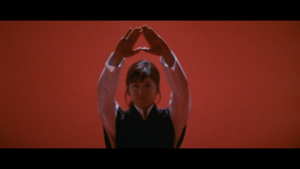 Since the inception of SDAFF’s Mystery Kung Fu Theatre, where no body knows what old classic kung fu film is going to be screened, it’s always been on the only day I can’t make it or far to late in the evening for me. As luck, fate or destiny has it, I was able to finally attend the show.
Since the inception of SDAFF’s Mystery Kung Fu Theatre, where no body knows what old classic kung fu film is going to be screened, it’s always been on the only day I can’t make it or far to late in the evening for me. As luck, fate or destiny has it, I was able to finally attend the show.
After watching Sister Street Fighter (SSF; 1974), “eye” have to admit that “eye” have never seen so many eyes destroyed in one movie. I mean there are gouged eyes, darts in eyes, knives and kamas (a hand sickle) in eyes. There are more eye pokes in SSF than in a macular degeneration optometry clinic, and I should know because my wife did 10 years of eye research at UCLA Medical School.
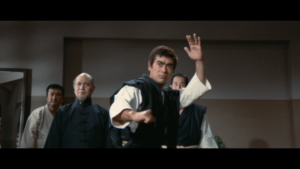 Actress Etsuko Shihomi got her first lead in this Street Fighter spin-off because her mentor, Sonny Chiba, was really pleased with her martial arts development work as the first female member of his Japan Action Club. In the film, she plays the half-Japanese, half-Chinese Hong Kong detective Li Koryu Koryu is sent to Japan to investigate the disappearance of her brother and fellow shorinji kempo (Japanese for Shaolin kung fu) practitioner Li Mansai (Hiroshi Miyauchi). Mansai had infiltrated a drug smuggling group in Hong Kong that has ties with Japan’s Central Trading, and now he may be deader than a cow in a Kobe steak house, making his martial arts a mooooo-t point.
Actress Etsuko Shihomi got her first lead in this Street Fighter spin-off because her mentor, Sonny Chiba, was really pleased with her martial arts development work as the first female member of his Japan Action Club. In the film, she plays the half-Japanese, half-Chinese Hong Kong detective Li Koryu Koryu is sent to Japan to investigate the disappearance of her brother and fellow shorinji kempo (Japanese for Shaolin kung fu) practitioner Li Mansai (Hiroshi Miyauchi). Mansai had infiltrated a drug smuggling group in Hong Kong that has ties with Japan’s Central Trading, and now he may be deader than a cow in a Kobe steak house, making his martial arts a mooooo-t point.
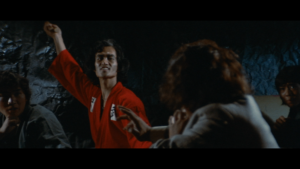 To find her brother, Koryu seeks the help of her shorinji kempo sensei. Her sensei promptly picks out his top kick-butt student Seiichi Hibiki (Sonny Chiba) to help Koryu get Yakuza boss Kakuzaki (Bin Amatsu). The only problem is that Kakuzaki has surrounded himself with a batch of violent villains that include seven female Thai kickboxers clothed in leopard skin, a banshee-screaming nunchaku nut dressed in a red gi (the coolest villain in the film), a karate-cutting killer, the intimidating black basket straw hat bunch and other weapon-wielding and unarmed assassins. And there is also the icy shorinji kempo hating Inubashi (Masashi Ishibashi), who would think nothing of putting razor blades in his mother’s coffee to give it a sharper flavor.
To find her brother, Koryu seeks the help of her shorinji kempo sensei. Her sensei promptly picks out his top kick-butt student Seiichi Hibiki (Sonny Chiba) to help Koryu get Yakuza boss Kakuzaki (Bin Amatsu). The only problem is that Kakuzaki has surrounded himself with a batch of violent villains that include seven female Thai kickboxers clothed in leopard skin, a banshee-screaming nunchaku nut dressed in a red gi (the coolest villain in the film), a karate-cutting killer, the intimidating black basket straw hat bunch and other weapon-wielding and unarmed assassins. And there is also the icy shorinji kempo hating Inubashi (Masashi Ishibashi), who would think nothing of putting razor blades in his mother’s coffee to give it a sharper flavor.
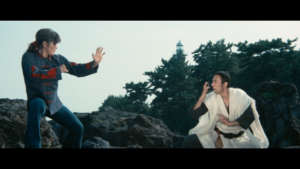 During her first few fights, Etsuko Shihomi’s postures and kicks are very reminiscent of famous Hong Kong super star Angela Mao Ying that most Westerners would know she played Bruce Lee’s sister in Enter the Dragon (1973). In particular, the way Shihomi kicks and positions her arms after a strike while waiting for the next opponent to attack is very Mao Ying. Yet during later fights in this film, Shihomi drops the Mao Ying look-a-like postures and lets her karate background shine through. In an awesome fight scene, Shihomi twists an attacker’s head 180 degrees. With his head on backward, the attacker walks down a staircase while spewing blood from his mouth. Koryu’s final fight is an ocean side cliffhanging duel against the boss who does the ole Enter the Dragon Han man iron claw gag, which features a convoluted high-wire gag. Of cute interest, prior to fighting the Han man aper, Koryu must chase him through a dark cave; you’ve got to love the fake bats on strings that flutter around Koyru’s head. But Koryu did not bat an eyebrow.
During her first few fights, Etsuko Shihomi’s postures and kicks are very reminiscent of famous Hong Kong super star Angela Mao Ying that most Westerners would know she played Bruce Lee’s sister in Enter the Dragon (1973). In particular, the way Shihomi kicks and positions her arms after a strike while waiting for the next opponent to attack is very Mao Ying. Yet during later fights in this film, Shihomi drops the Mao Ying look-a-like postures and lets her karate background shine through. In an awesome fight scene, Shihomi twists an attacker’s head 180 degrees. With his head on backward, the attacker walks down a staircase while spewing blood from his mouth. Koryu’s final fight is an ocean side cliffhanging duel against the boss who does the ole Enter the Dragon Han man iron claw gag, which features a convoluted high-wire gag. Of cute interest, prior to fighting the Han man aper, Koryu must chase him through a dark cave; you’ve got to love the fake bats on strings that flutter around Koyru’s head. But Koryu did not bat an eyebrow.
Here’s something so cooool about the film that could never have been written before until this year.
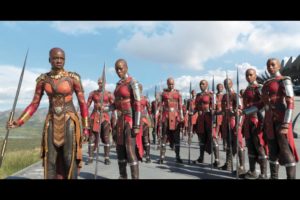 In the movie Black Panther the most hyped up fighting characters were the Dora Milaje (adored ones), a cadre of strong fierce women who serve as bodyguards to the King and royal family. These tall, statuesque bald-headed women warriors were under the firm command of Okoye (Danai Gurira).
In the movie Black Panther the most hyped up fighting characters were the Dora Milaje (adored ones), a cadre of strong fierce women who serve as bodyguards to the King and royal family. These tall, statuesque bald-headed women warriors were under the firm command of Okoye (Danai Gurira).
The filmmakers raved about Okoye’s oner, a misleading term being used by writers and filmmakers to describe a fight sequence where it’s done in one take. A one-take fight is more properly defined as an unedited shot of at least 2 or more minutes where the fight is the whole scene. Okoye’s oner is an 11-second, 10-move sequence on a balcony during a mass brawl scene in a Korean casino. At this stage of the film and on, some camera choreography mirrors the way Hong Kong film fights were shot in the ’80s and ’90s where the camera shifts to the fighter’s body’s parts doing the technique…shot of a kick, tilt up to a fist, pan with fist hitting target, pan back on fist to attacker’s body, tilt down to the foot. Worthy tries but the DP didn’t know when to slightly pull back for smooth continuity. Instead, they used snappy tilts, pans and dizzying earthquake camera to cover the actors inadequacy.
 If you watch SSF again, you’ll notice that all of Shihomi fights are comprised of a string of oners, sometimes up to having six, 10-12 second oners in a row in the same fight, using wide angles…and again, that was back in 1974. Enough said.
If you watch SSF again, you’ll notice that all of Shihomi fights are comprised of a string of oners, sometimes up to having six, 10-12 second oners in a row in the same fight, using wide angles…and again, that was back in 1974. Enough said.
Hong Kong kung fu films often show stars doing martial arts during the film’s opening credits. Similarly, SSF features Shihomi dressed in full shorinji kempo attire doing spinning kicks, twirling nunchakus and whirling sais (dagger-like weapons). It prepares the audience for the kind of martial arts the film will feature. It also was the first Japanese karate film to introduce a heroine during the opening credits.

 tweet
tweet share
share